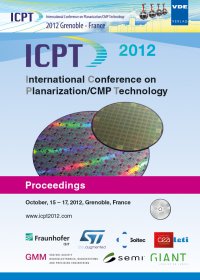Smart pad dressing for double-side polishing
Konferenz: ICPT 2012 - International Conference on Planarization / CMP Technology
15.10.2012-17.10.2012 in Grenoble, France
Tagungsband: ICPT 2012
Seiten: 6Sprache: EnglischTyp: PDF
Persönliche VDE-Mitglieder erhalten auf diesen Artikel 10% Rabatt
Autoren:
Kanzow, J.; Werth, S.; Mörsch, G. (Peter Wolters GmbH, 24768 Rendsburg, Germany)
Inhalt:
Simultaneous double-side processing of semiconductor work pieces with a planetary kinematics is a standard way to achieve flat work piece geometry. It has become mandatory for 12?? silicon prime wafer stock polishing. An ideal flatness of the machine’s upper and lower pad surface geometry is a good choice for such a double-side polishing process. However, pad pre-compressing and slurry distribution effects lead to a modified wafer edge profile during polishing which cannot be corrected completely, e.g. by adapted workpiece holder (“carrier”) geometry. A smart way to control the wafer edge geometry is to trim the polishing pad edges to a well-defined extent (fig. 5). Due to the planetary kinematics, the workpiece edges will temporarily be exposed to a reduced pressure during the process with the effect of a reduced local workpiece removal. Depending on the pad edge trimming extent (i.e. pad’s radial roll-off profile), the workpiece edge geometry can be adjusted to a 1 mm edge exclusion. The pad edge trimming can be performed by using stiff dressing carriers (see fig. 3) in a machine with a platen geometry adaptive control. One platen’s geometry can be adapted fastly, e.g. by a hydro-pneumatic system, resulting in a localized dressing at the outer and inner pad edges, respectively. The pad’s radial roll-off profile is controlled by dressing time and force and platen’s geometry adaption extent. The remaining pad surface area becomes flat during a separate dressing step with the same stiff dressing tool. We show that the 12?? silicon prime wafer geometry can be optimized significantly making this method a good candidate for the 22 nm technology node (fig. 9). Keywords: Double-side polishing, DSP, Pad dressing, Dressing carrier, UPAC, Peter Wolters


